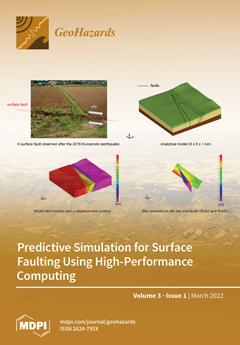The 27 September 2021 damaging mainshock (M
w6.0) is the first known strong earthquake that ruptured the Arkalochori area, Crete Isl., Greece, during the entire historical period, making it an unexpected event in the long-term sense. The area is characterized by the
[...] Read more.
The 27 September 2021 damaging mainshock (M
w6.0) is the first known strong earthquake that ruptured the Arkalochori area, Crete Isl., Greece, during the entire historical period, making it an unexpected event in the long-term sense. The area is characterized by the presence of the normal active Kastelli Fault (KF) striking NNE-SSW and dipping towards ~WNW. The KF, of surface exposure only ~6 km, at its southern tip is truncated by the nearly perpendicular active Nipiditos fault. The main shock was preceded by foreshock activity lasting for ~3.9 months, thus the mainshock turned out to be an expected event in the short-term sense. Maximum ground subsidence of ~20 cm was estimated from InSAR images, but this also incorporates deformation that may have been caused by the largest aftershock (M
w5.1) of 28 September 2021. The fault model produced from the inversion of InSAR observations indicated strike 216°, dip towards ~NW at angle 53°, rake −95°, and is consistent with fault-plane solutions obtained from routine moment tensor analysis. The geodetic seismic moment calculated from the Okada’s formalism is 1.14 × 10
18 N·m (M
w6.0), while a maximum slip of 1.03 m was found at depths from 3.5 km to 5 km. The entire aftershock epicenters cloud strikes in a ~SW-NE direction but is distributed in two clusters, the southern and the northern ones. The foreshock cloud, the main slip patch, the deformation area, and the strongest aftershocks all fall within the southern cluster. The foreshocks concentration at the deepest edge of the main slip patch was a foreshadow of the mainshock nucleation area. The northern cluster, which is very likely due to the gradual expansion of aftershocks, is situated in the KF hanging wall block. To interpret the main seismic slip in the southern cluster area we propose the existence of a buried KF segment at the SSW-wards prolongation of the emerged at the surface segment. Assuming a rectangular seismic fault stress drop Δσ~7 bars was found. However, for a circular fault area, which in this case is more realistic, we get Δσ = 55 bars. This is a relatively large value for Greek earthquakes but is explainable by increased fault rigidity as a result of the long repeat time of strong earthquakes in KF.
Full article





